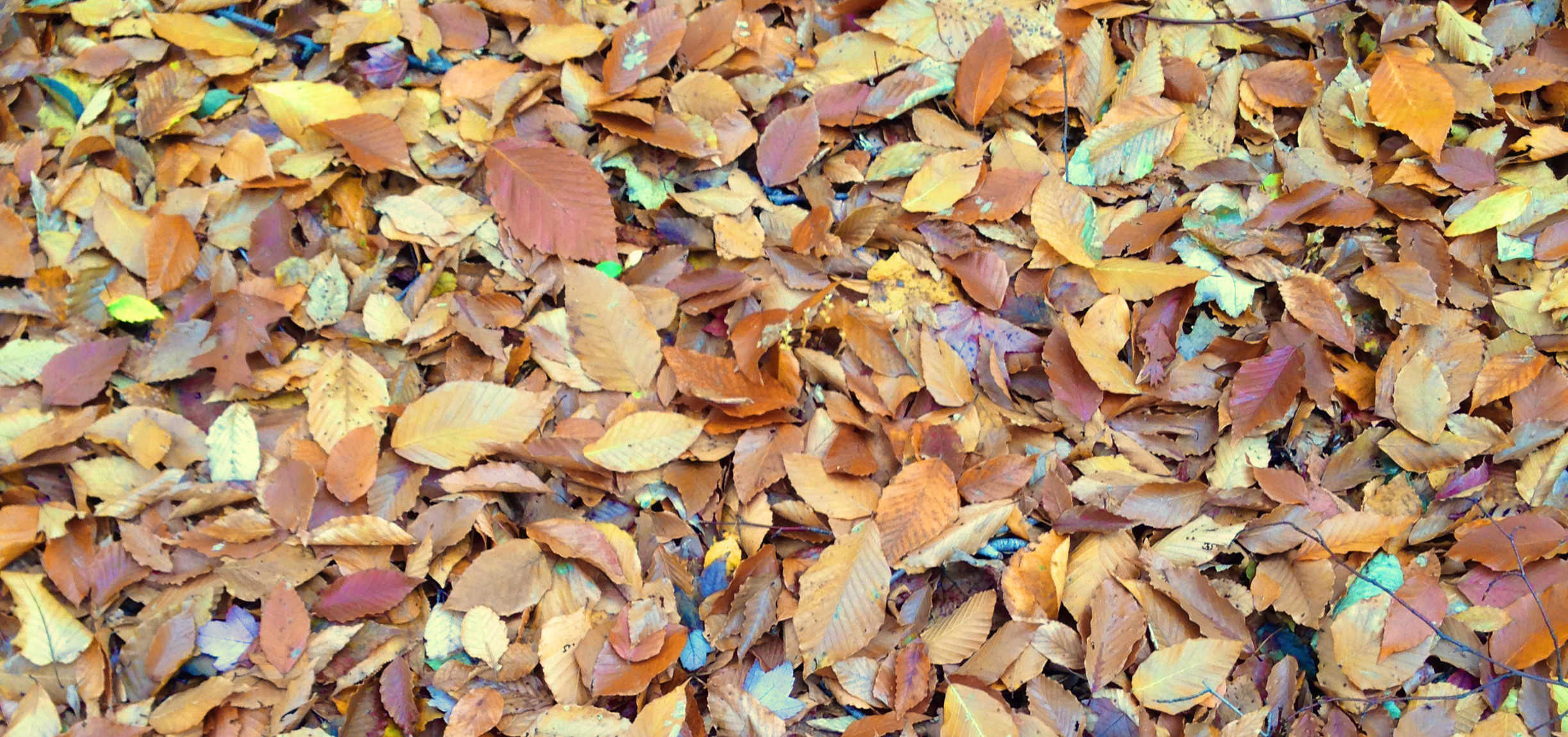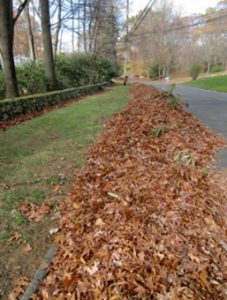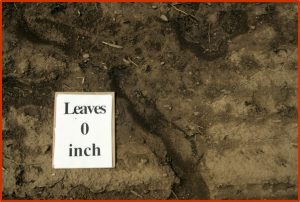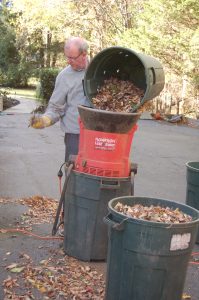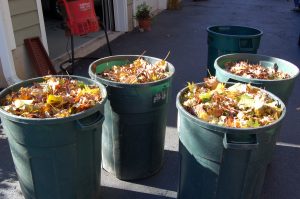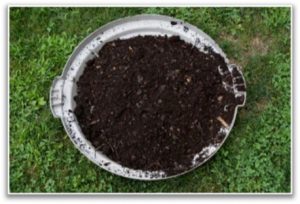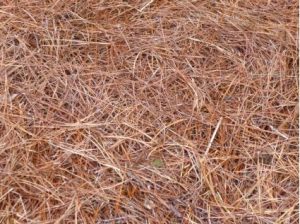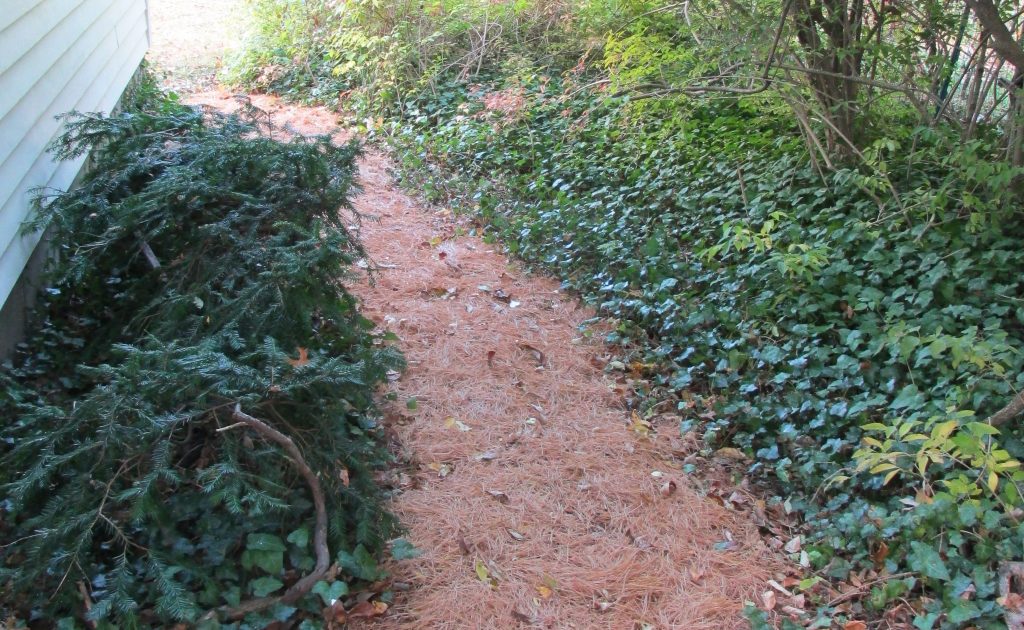First posted November 2017
Autumn leaves offer so many benefits to our gardens, why waste them by blowing or throwing them away?
Here in Mercer County, we have a lot of leaves to contend with at this time of the year–and corralling and collecting them can add up to a towering outdoor chore. If you’re not looking forward to spending your fall weekends blowing or raking all those leaves out to the curb for pickup, there’s good news: You don’t have to! That’s right, not only is all that bagging and blowing unnecessary, keeping those leaves on your property will also do wonders for your garden, and help the community too!
The Harder They Fall…
…the better it is for you! When it comes to leaves, there’s almost no such thing as too many. What’s so good about fallen leaves? Here are our top three:
- Leaves are a natural soil builder
- They reduce the need for fertilizer on our lawns and gardens
- They offer excellent winter insulation for plants, animals, and potted bulbs
There are a few types of leaves you might not want to keep.
Scroll down for info on the few exceptions to the ‘Leave the Leaves’ rule.
That’s the Spirit: Helping Towns and Ecosystems
Significant as they are for your own garden, the benefits of holding onto your leaves stretch well past your property line. For one thing, not blowing leaves to the curb keeps them out of storm drains where they can release excess phosphorus into our water supply–polluting waterways and contributing to excess algae that can deplete oxygen in lakes and streams, killing fish and other aquatic life.
Even if they don’t make it into drains, leaves left at the curb can cover and clog storm drains, exacerbating fall flooding problems.
On some streets, trying to drive (or bike) through narrow gauntlets of leaf piles becomes a navigation nightmare. Leaves at the curb are also slippery underfoot as they blow back onto sidewalks, driveways, streets, and parking lots.
One other thing to ponder: lowering the size of the leaf piles at the curb means fewer pickups, which can add up to lower municipal collection costs–wouldn’t THAT be a welcome windfall?
In 1988, New Jersey banned leaves from landfills and incinerators. Collected leaves are now generally composted at municipal, regional, and commercial sites. In addition, NJ farmers also make use of leaves collected from municipalities, and find they make both effective soil builders (through composting) and great field mulch.
Better Ways of Dealing with Leaves:
We’ve come up with some easy alternatives to piling leaves along the curb for pickup. Most require little or no investment, but all pay big dividends in healthier gardens and lower environmental costs.
The Mow Down: Mulching leaves into the lawn
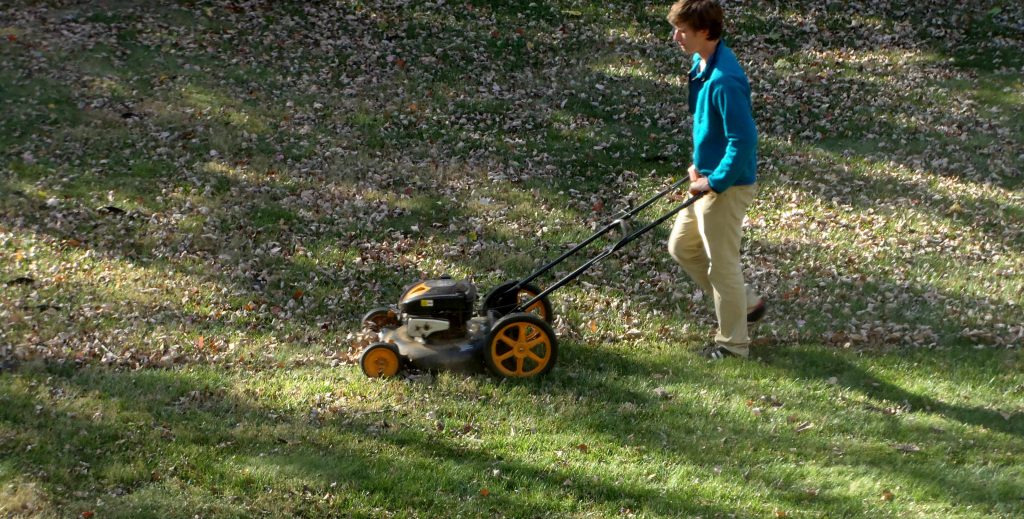
Mulch mowing is the simplest method of dealing with leaves that land on the lawn. (Photo by Louise Senior)
Simply leaving leaves where they fall is fine in wooded areas, but as most homeowners already know, if leaves are left to pile up on lawns, before long they would become too thick and kill the grass! A better strategy: Simply mow them back into the lawn.
Depending on the type of mower you have, you can either switch to the mulch setting or make several passes over dry leaves to cut and re-cut them into fine particles. Either way, letting the small pieces drop between the blades of grass will allow microbes to further break them down. Over time, the mulch will release nutrients into the lawn and provide much-needed organic matter to the soil. Be sure to keep the blade height at about three inches.
One caveat to mulching leaves into the grass: After you mow over the leaves, make sure you can see green grass underfoot. If all you see when you look down is ground leaves—keep mowing. Leaves that are not shredded finely enough can smother and kill the grass.
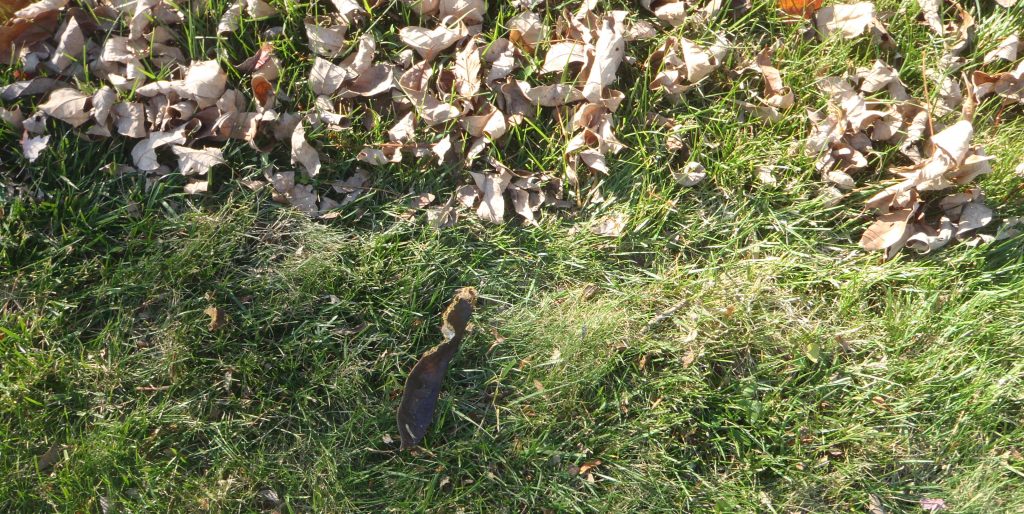
Once mowed, check to be sure that grass is easily visible through the mulched leaves. If only mulched leaves are seen, they will block sunlight and possibly kill the lawn beneath. (Photo by Louise Senior)
It’s always best to mulch mow when the leaves are dry. Mulch mowing is also easiest to do when the layer of leaves is not too thick. The more powerful the mower though, the heavier the layer of leaves it can get through. Don’t own a lawn mower? Professional landscapers can be directed to mulch leaves into the grass as they mow your property. And, in case you’re wondering, mulch mowing is absolutely not correlated with thatching in lawns. (For more on what does cause thatch, see THE BASICS OF SUCCESSFUL LAWN CARE.)
Hitting Pay Dirt: Improving the soil
Shunting some of those fallen leaves into your garden beds will pay off big time in improved soil. Scientific research conducted by the New Jersey Agricultural Experiment Station has shown that adding a layer of leaves improves the water-holding capacity of soil, reducing drought damage and improving the “tilth” of the soil, i.e. how loose and crumbly it is. Loose, crumbly or “friable” soil is exactly what all gardeners should be shooting for–not only because it makes gardens easier to dig, but also because friable soil allows water to drain better and helps supply air and nutrients to the root systems. Plus, as leaves break down into compost, they help soil hold nutrients longer, reducing the effects of excess fertilization, and providing food for beneficial soil micro-organisms.
Take Cover: Leaves as insulation
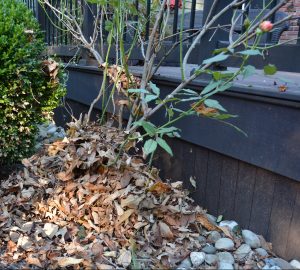
The climbing rose bush pictured above–like a lot of shrubs on the borderline for hardiness in our zone– benefits from the winter protection provided by a blanket of fall leaves. (Photo by Catherine Horgan)
Fall leaves are great for protecting plants against freezing winter weather.
When it comes to gardens, it may be surprising to learn that freezing temps and drying winds are actually worse than snow. The fact is, snow acts as a kind of insulation, shielding plants from the coldest temperatures.
If we end up with a decent covering of snow during the coldest months, even somewhat tender plants will do just fine. But since we can’t always count on adequate snow cover, adding a layer of leaves can provide a little extra protection.
Simply rake the leaves up and over, to cover the plants. Be sure to remove the leaves in early spring (and add them to your compost pile.) Among the tender plants that will appreciate some protection: agapanthus, rosemary, and some types of lavender. Edible plants, such as garlic, strawberries and asparagus, also benefit from the protective winter insulation of a layer of leaves.
Another use for the insulating power of leaves is shown here: Potted bulbs can be set outside and covered with leaves. That way, the bulbs get the chilling they need to bloom, but a layer of leaves keep the pots and bulbs from freezing.
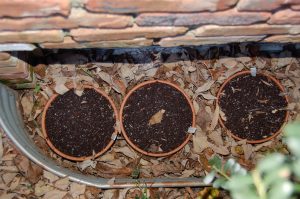
Leaves make great insulation when forcing spring bulbs like the tulips pictured above. (Photo by Catherine Horgan)
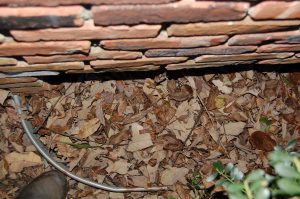
A top dressing with leaves ensures the bulbs are shielded from freezing temperatures. (Photo by Catherine Horgan)
In this instance, tulip bulbs were potted up, tucked into a window well, and surrounded with leaves. A top layer of leaves covers the pots completely, insulating them from killing frosts until it’s time to bring them inside, where they’ll be forced into early bloom.
(For more information on forcing bulbs, see Spring Flowering Bulbs.)
Nurturing Nature: Wildlife protection
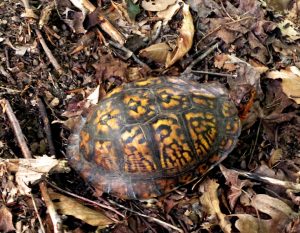
Both decayed and fresh leaf litter are important for over wintering wildlife, like this eastern box turtle. (Photo by Margaret Montplaisir)
Leaves don’t just provide protection for plants. Layering leaves in your garden provides winter refuge for wildlife too. Salamanders, box turtles, toads, and shrews all either live in, or rely on, the leaf layer for food. Welcome them! They are all beneficial in keeping down the number of harmful bugs in your gardens.
Several butterfly and moth species also overwinter in leaf litter. You may not have realized that if you get rid of the leaves, you potentially get rid of some beautiful and beneficial insects too. All those butterflies and moths that are allowed to overwinter in the leaf litter will help other species too. Think about all those caterpillars they will produce in the spring, which will provide lots of food for birds to feed their hungry babies.
Neat and Nutritious: Turning leaves into mulch
Dried leaves also make a wonderful mulch for garden beds. Cost effective and nutrient filled, they are a superior alternative to wood chips and dyed bark mulches. When considering using leaves as garden mulch, it’s always best to shred them first. (See How-to’s below.) Some leaves—like maples—are flat and tend to clump together forming a mat that can prevent moisture from reaching the soil. Shredded leaves look neater and are less likely to swirl around and out of beds. And, unlike whole leaves, won’t form a heavy mat that can keep moisture from reaching winter-parched plants.
Shredded leaf mulch offers the added bonus of keeping weeds at bay. In the fall, after you’ve weeded your beds one final time, add a thick layer of shredded leaves on top. Since most seeds require light to germinate, the blanket of shredded leaves will help keep weeds from reappearing.
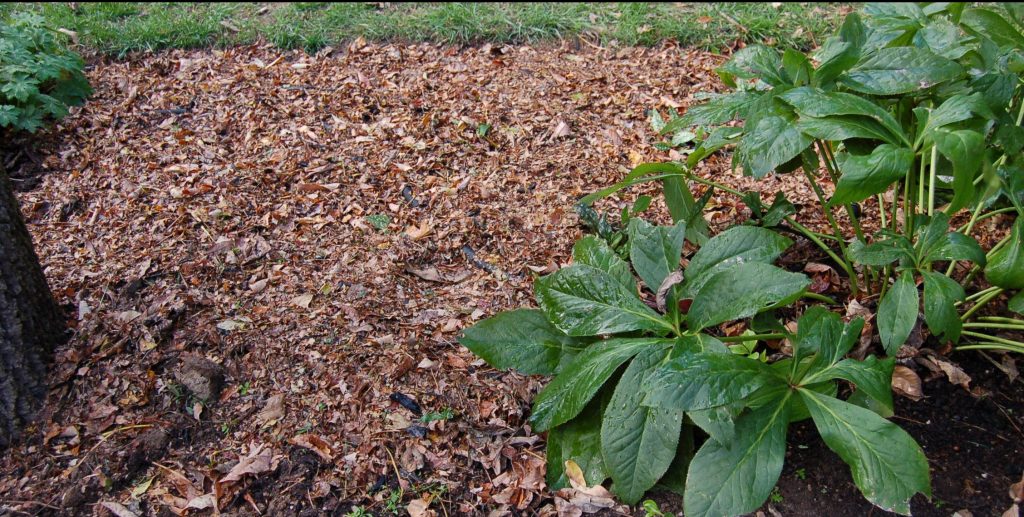
Using shredded leaves in flower beds is both an attractive and wallet friendly alternative to purchased mulches. (Photo by Catherine Horgan)
Chop, Chop: Leaf shredding how-to
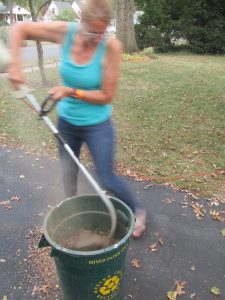
Shredding leaves using a string trimmer saves space and helps them break down more easily. (Photo by Louise Senior)
Leaf shredding doesn’t have to be a big deal–but it really does make a big dent in the volume of leaves you have to deal with. Depending on how finely you chop them, shredded leaf volume can drop to less than a quarter of the space needed for whole leaves. In addition to cutting leaf piles down to size, the smaller pieces decompose faster.
Here are a few easy and cost-effective shredding methods to try:
String Trimmers: Use this lawn-manicuring staple to make short work of leaves. Just collect leaves in bins and churn through the pile with the trimmer until leaves are chopped into small pieces.
Leaf Blowers: Instead of using this tool to pile leaves up at the curb, use the reverse or vacuum mode with a bag attachment to collect and shred leaves in one step.
(Note: Some leaf blowers have small-ish collection bags which can fill up quickly. If you have tons of leaves, try emptying them onto beds as you go.)
Leaf Shredders: There are lots of lightweight leaf shredders on the market in a variety of price ranges. Most perch on edge of collection bins for easy collection and storage.
Regardless of the shredding method you use, make sure you use eye protection to prevent injury from any little twigs you might have picked up.
Give It a Rest: Creating leaf compost
Maybe the easiest way to take advantage of all the good stuff leaves have to offer is to just gather them up and let them sit–creating leaf compost or leaf mold.
You don’t need any special equipment to make leaf compost, just a little space to put a plastic bag or two. Simply bag up your leaves, and add a little moisture if they are dry. Close the bag, and leave it be for about six months. Come spring: Tah-dah! You’ll be the proud possessor of the dark, earthy-smelling garden gold know as leaf mold or leaf compost.
As a rule, a healthy dose of leaf mold is already present in Autumn leaves–which is a good thing since that’s what gets the decomposition process started. But if this is your first try with “bag-and-let-it-sit” leaf composting, it might not be a bad idea to add a handful of compost, or healthy garden soil to the leaves to help them get started.
Leaf compost is a wonderful addition to gardens, supplying organic matter that improves soil structure and provides nutrients. Use the compost when you install new plants, or you can spread it on your flower gardens in spring. Properly maintained, a compost pile does not smell.
If you already have a compost bin but have more leaves in autumn than your bin can handle, store leftover leaves in bags or bins. Shredding first can save a lot of space. Depending on how finely shredded the leaves are, they can take as little as one-sixteenth the space of whole leaves.
Space-saving shreds:
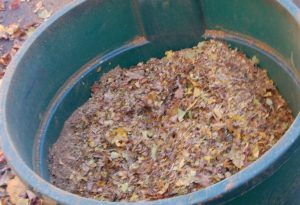
The smaller the pieces, the faster they decompose and the quicker you will be cashing in on all that “garden gold” (aka compost)
Even unshredded, leftover fall leaves will provide home composters with a ready supply of beneficial “browns” to use all summer, when dry leaves are in short supply. (For more info on how to make compost, see COMPOSTING AT HOME.)

In midsummer, there are fewer leaves available– so why not store some in bins now, while they’re plentiful. That way you’ll always have a ready supply for composting. (Photo by Catherine Horgan)
Southern Comfort: Using pine needles in the garden
Not all fall leaves come from deciduous trees–just ask anyone with a plethora of white pines on their property! Pine trees also shed their “leaves” at this time of year, in the form of dropped needles.
Pine needles make great garden mulch and are a popular addition to southern gardens, where they’re often known as pine-straw. Gardeners in the northeast can also take advantage of this attractive leaf alternative. Pine needles can be added right into compost bins or raked straight onto garden beds, no need to shred them.
And if you have a muddy path, pine needles make a great mulch in those areas too.
Some people might shy might away from using pine needles in their beds because they are afraid that the pH of the needles is too low for many plants. Not so! Just like deciduous leaves, plants thrive on them -think of all those beautiful blueberries, azaleas and rhododendrons in New Jersey’s Pine Barrens and Delaware Water Gap forests.
If there is a disadvantage to using pine needles, it’s their tendency blow around in heavy winds (because they are so light). If you have gardens that are exposed to heavy winds, consider saving pine needles for use in more sheltered areas.
Gotta Go: Leaves you shouldn’t leave in your yard
Most home landscape leaves are fine for composting and the other uses suggested here; however, there are a few types of leaves that homeowners may want to remove from their properties. Because of allergic reactions, many homeowners choose to discard poison ivy, poison oak, and poison sumac leaves rather than risk the adverse effects of handling them.
Black walnut leaves contain juglone which inhibits plant growth. A few walnut leaves will not harm your compost, but a large concentration of black walnut leaves may be better left for municipal pick-up where their effects will be ‘diluted’ down the line.
Diseased plant material, such as blighted tomato and squash plants, are generally better bagged and added to trash as most home compost regimes do not kill off the diseases.
Beech, birch, hornbeam, sweet chestnut, magnolia and holly all contain high amounts of lignin (the structural material in trees), and these should be shredded before composting to speed their breakdown.
The popular belief that oak leaves increase acidity does not affect their use in compost; it is perfectly fine to include all of your oak leaves in the practices described here.
Fun & Frolic: Leafy fall decor
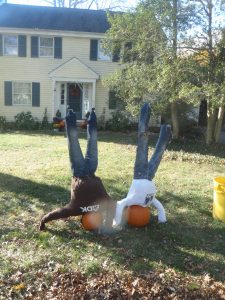
Turn your usual approach to leaves on it’s head: Instead piling them at the curb, add them to your fall decor, like these leaf-stuffed scarecrows. (Photo by Louise Senior)
Deciduous trees are such a boon to our properties all year long. They not only look beautiful in summer but store carbon and release oxygen into the air. They trap odors and pollutant gases and provide much-needed shade in the heat. But they are perhaps at their most spectacular at this time of year when their brilliant colors end the gardening season in a blaze of glory.
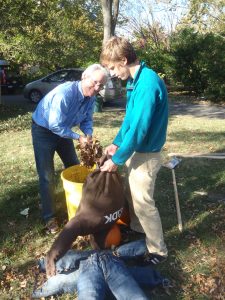
Take it easy: Don’t rake first–just scoop up whatever leaves have fallen right around your scarecrow. (Photo by Louise Senior)
Why not extend the splendor of the trees in your own yard by clipping small leaf-filled branches to make easy arrangements, wreaths, bowls, and so much more.
You can also use leaves to stuff the clothes of scarecrows. By Thanksgiving, the leaves inside will have already started to break down into garden-nourishing leaf mulch. When you empty the scarecrow’s clothes, add what’s left to your compost pile, or bag them up and let them sit for the rest of the winter.
If you’re bagging up leaves for compost anyway, why not use bags that do double duty as holiday décor, like these decorative pumpkin sacks? When your Halloween décor gives way to other decorations, just add a little water to the leaves in the sack and put the bag aside, where it will reward you with a batch scary-good leaf mold come spring.
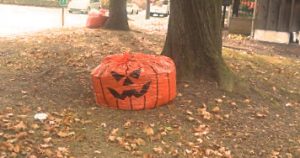
Boo-full baggers beware: Some decorative sacks can break down over the winter. Use caution when moving them in the Spring. (Photo by Louise Senior)
In the end, leaves offer so many benefits to our gardens, it seems a such shame to waste them by throwing them away. So whatever way you decide to use them in your landscape this year–be sure to leave the leaves! Happy Fall!

